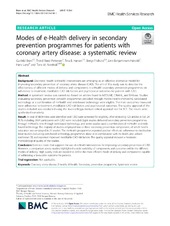| dc.contributor.author | Brørs, Gunhild | en_US |
| dc.contributor.author | Pettersen, Trond Røed | en_US |
| dc.contributor.author | Hansen, Tina B. | en_US |
| dc.contributor.author | Fridlund, Bengt Gotthard Anton | en_US |
| dc.contributor.author | Hølvold, Linn Benjaminsen | en_US |
| dc.contributor.author | Lund, Hans | en_US |
| dc.contributor.author | Norekvål, Tone M. | en_US |
| dc.date.accessioned | 2019-12-19T12:30:35Z | |
| dc.date.available | 2019-12-19T12:30:35Z | |
| dc.date.issued | 2019-06-10 | |
| dc.Published | Brørs G, Pettersen TR, Hansen, Fridlund BGA, Hølvold LB, Lund H, Norekvål TM. Modes of e-Health delivery in secondary prevention programmes for patients with coronary artery disease: A systematic review. BMC Health Services Research. 2019;19:364 | eng |
| dc.identifier.issn | 1472-6963 | |
| dc.identifier.uri | https://hdl.handle.net/1956/21194 | |
| dc.description.abstract | Background: Electronic health (e-Health) interventions are emerging as an effective alternative model for improving secondary prevention of coronary artery disease (CAD). The aim of this study was to describe the effectiveness of different modes of delivery and components in e-Health secondary prevention programmes on adherence to treatment, modifiable CAD risk factors and psychosocial outcomes for patients with CAD. Method: A systematic review was carried out based on articles found in MEDLINE, CINAHL, and Embase. Studies evaluating secondary prevention e-Health programmes provided through mobile-Health (m-Health), web-based technology or a combination of m-Health and web-based technology were eligible. The main outcomes measured were adherence to treatment, modifiable CAD risk factors and psychosocial outcomes. The quality appraisal of the studies included was conducted using the Joanna Briggs Institute critical appraisal tool for RCT. The results were synthesised narratively. Result: A total of 4834 titles were identified and 1350 were screened for eligibility. After reviewing 123 articles in full, 24 RCTs including 3654 participants with CAD were included. Eight studies delivered secondary prevention programmes through m-Health, nine through web-based technology, and seven studies used a combination of m-Health and webbased technology. The majority of studies employed two or three secondary prevention components, of which health education was employed in 21 studies. The m-Health programmes reported positive effects on adherence to medication. Most studies evaluating web-based technology programmes alone or in combination with m-Health also utilised traditional CR, and reported improved modifiable CAD risk factors. The quality appraisal showed a moderate methodological quality of the studies. Conclusion: Evidence exists that supports the use of e-Health interventions for improving secondary prevention of CAD. However, a comparison across studies highlighted a wide variability of components and outcomes within the different modes of delivery. High quality trials are needed to define the most efficient mode of delivery and components capable of addressing a favourable outcome for patients. | en_US |
| dc.language.iso | eng | eng |
| dc.publisher | BioMed Central | eng |
| dc.rights | Attribution CC BY | eng |
| dc.rights.uri | http://creativecommons.org/licenses/by/4.0 | eng |
| dc.subject | Coronary artery disease | eng |
| dc.subject | E-health | eng |
| dc.subject | M-health | eng |
| dc.subject | Secondary prevention programme | eng |
| dc.subject | Systematic review | eng |
| dc.title | Modes of e-Health delivery in secondary prevention programmes for patients with coronary artery disease: A systematic review | en_US |
| dc.type | Peer reviewed | |
| dc.type | Journal article | |
| dc.date.updated | 2019-08-09T12:03:39Z | |
| dc.description.version | publishedVersion | en_US |
| dc.rights.holder | Copyright 2019 The Author(s) | |
| dc.identifier.doi | https://doi.org/10.1186/s12913-019-4106-1 | |
| dc.identifier.cristin | 1710633 | |
| dc.source.journal | BMC Health Services Research | |

